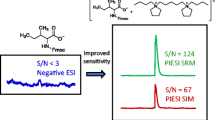Abstract
In diseases accompanied by strong metabolic disorders, like cancer and AIDS, modifying enzymes are up- or down-regulated. As a result, many different types of metabolic end-products, including abnormal amounts of modified nucleosides, are found in urine. These nucleosides are degradation products of an impaired ribonucleic acid (RNA) metabolism, which affects the nucleoside pattern in urine. In several basic experiments we elucidated the fragmentation pathways of 16 characteristic nucleosides and six corresponding nucleic bases that occur in urine using electrospray ionization ion trap MS5 (ESI-ITMS) experiments operated in positive ionization mode. For urinary nucleoside analysis, we developed an auto-LC–MS3 method based on prepurification via boronate gel affinity chromatography followed by reversed phase chromatography. For this purpose, an endcapped LiChroCART Superspher RP 18 column with a gradient of ammonium formate and a methanol–water mixture was used. This method gives a limit of detection of between 0.1 and 9.6 pmol for 15 standard nucleosides, depending on the basicity of the nucleoside. Overall, the detection of 36 nucleosides from urine was feasible. It was shown that this auto-LC–MS3 method is a valuable tool for assigning nucleosides from complex biological matrices, and it may be utilized in the diagnosis of diseases associated with disorders in RNA metabolism.





Similar content being viewed by others
References
McCloskey JA, Crain PF (1998) Nucleic Acids Res 26:196–197
Bjoerk GR, Ericson JU, Gustafsson CED, Hagervall TG, Joensson YH, Wikstroem PM (1987) Annu Rev Biochem 56:63–87
Schram KH (1998) Mass Spectrom Rev 17:131–251
Nakano K, Nakao T, Schram KH, Hammargren WM, McClure TD, Katz M, Petersen E (1993) Clin Chim Acta 218:69–83
Dieterle F, Muller-Hagedorn S, Liebich HM, Gauglitz G (2003) Artif Intell Med 28:65–79
Hammargren WM, Schram KH, Nakano K, Yasaka T (1991) Anal Chim Acta 247:201–209
Heldman DA, Grever MR, Speicher CE, Trewyn RW (1983) J Lab Clin Med 101:783–792
Itoh K, Konno T, Sasaki T, Ishiwata S, Ishida N, Misugaki M (1992) Clin Chim Acta 206:181–189
Ravdin PM, Clark GM (1992) Breast Cancer Res Treat 22:285–293
Sasco AJ, Rey F, Reynaud C, Bobin JY, Clavel M, Niveleau A (1996) Cancer Lett 108:157–162
Tamura S, Fujii J, Nakano T, Hada T, Higashino K (1986) Clin Chim Acta 154:125–132
Tormey DC, Waalkes TP, Gehrke CW (1975) J Surg Oncol 14:267–273
Waalkes TP, Abeloff MD, Ettinger DS, Woo KB, Gehrke CW, Kuo KC, Borek E (1982) Eur J Cancer Clin Oncol 18:1267–1274
Xu G, Schmid HR, Lu X, Liebich HM, Lu P (2000) Biomed Chromatogr 14:459–463
Dudley E, Lemiere F, Van Dongen W, Langridge JI, El Sharkawi S, Games DE, Esmans EL, Newton RP (2003) Rapid Commun Mass Spectrom 17:1132–1136
Gehrke CW, Kuo KC, Davis GE, Suits RD, Waalkes TP, Borek E (1978) J Chromatogr 150:455–476
Liebich HM, Di Stefano C, Wixforth A, Schmid HR (1997) J Chromatogr A 763:193–197
Liebich HM, Xu G, Di Stefano C, Lehmann R (1998) J Chromatogr A 793:341–347
Dudley E, Lemiere F, Van Dongen W, Langridge JI, El Sharkawi S, Games DE, Esmans EL, Newton RP (2001) Rapid Commun Mass Spectrom 15:1701–1707
Dudley E, El Sharkawi S, Games DE, Newton RP (2000) Rapid Commun Mass Spectrom 14:1200–1207
Esmans EL, Broes D, Hoes I, Lemiere F, Vanhoutte K (1998) J Chromatogr A 794:109–127
Nelson CC, McCloskey JA (1992) J Am Chem Soc 114:3661–3668
Nelson CC, McCloskey JA (1994) J Am Soc Mass Spectrom 5:339–349
Bordas-Nagy J, Despeyroux D, Jennings KR (1992) J Am Soc Mass Spectrom 3:502–514
Uziel M, Taylor SA (1978) J Carb-Nucleos-Nucl 5:235–249
Wulff UC, Desai LS, Heuer R, Meissner J, Foley GE (1975) Exp Cell Res 90:63–72
Chheda GB, Mittelman A, Grace JT Jr (1969) J Pharm Sci 58:75–78
Gehrke CW, Kuo KC, Waalkes TP, Borek E (1979) Cancer Res 39:1150–1153
McEntire JE, Kuo KC, Smith ME, Stalling DL, Richens JW Jr, Zumwalt RW, Gehrke CW, Papermaster BW (1989) Cancer Res 49:1057–1062
Thomale J, Nass G (1982) Cancer Lett 15:149–159
Chang ML, Johnson BC (1961) J Biol Chem 236:2096–2098
Limbach PA, Crain PF, McCloskey JA (1994) Nucleic Acids Res 22:2183–2196
Acknowledgements
The authors wish to thank Dr Burbiel from the Institute of Pharmacy, Friedrich-Wilhelms-University Bonn, for synthesis of 1-methylinosine. Antje Frickenschmidt is a recipient of a scholarship provided by the DFG Graduiertenkolleg Analytische Chemie of Tübingen University.
Author information
Authors and Affiliations
Corresponding author
Rights and permissions
About this article
Cite this article
Kammerer, B., Frickenschmidt, A., Müller, C.E. et al. Mass spectrometric identification of modified urinary nucleosides used as potential biomedical markers by LC–ITMS coupling. Anal Bioanal Chem 382, 1017–1026 (2005). https://doi.org/10.1007/s00216-005-3232-2
Received:
Revised:
Accepted:
Published:
Issue Date:
DOI: https://doi.org/10.1007/s00216-005-3232-2




